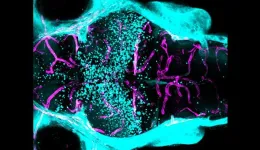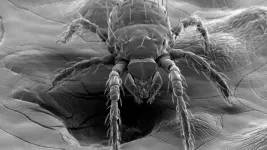(Press-News.org) At a glance:
Working with mice and zebrafish, researchers identify a gene, expressed in neurons, that produces a signal needed for development and maintenance of the blood-brain barrier.
When mutated, the gene makes certain regions of the blood-brain barrier more permeable.
The findings could help scientists control the blood-brain barrier — important for delivering drugs into the central nervous system or countering damage from neurodegenerative disease
What makes the vital layer of protective cells around the brain and spinal cord — the blood-brain barrier — more or less permeable has been one of the more mystifying questions in neuroscience.
Understanding how the barrier works to allow in or keep out certain substances has critical implications for everything from disease progression to drug delivery.
Now, a new Harvard Medical School study, published July 11 in Developmental Cell, has brought scientists a step closer to figuring it out.
Working in zebrafish and mice, the team discovered that a signal originating from a gene in neurons is essential for the proper formation of the blood-brain barrier during embryonic development and helps ensure that the barrier remains intact throughout adulthood.
If replicated in further animal testing and eventually in humans, the findings could help scientists control the permeability of the blood-brain barrier. In doing so, researchers may be able to develop more effective ways of delivering cancer or psychiatric medicines into the brain and better strategies for combating barrier damage caused by neurodegeneration or stroke.
Following the science
The blood-brain barrier is made of tightly interlaced cells — endothelial cells, pericytes, and astrocytes — lining the blood vessels of the brain and spinal cord that make up the central nervous system. Together, these cells form a layered, semipermeable membrane that selectively lets in nutrients and small molecules, while keeping out harmful substances.
“In normal, day-to-day life, you need a blood-brain barrier to help protect you from invading toxins and pathogens in the blood,” explained lead author Natasha O’Brown, a research fellow in systems biology at HMS who is starting her lab at Rutgers University in September.
In the case of neurodegenerative diseases such as Alzheimer’s or Parkinson’s, or stroke, the barrier begins to break down, leaving the central nervous system susceptible to infection. On the flip side, the impermeability of the barrier presents an obstacle for delivering drugs to the brain.
For decades, scientists have known that the permeability of the blood-brain barrier is in part controlled by cells in the surrounding environment — known as the microenvironment. However, the genes in those nearby cells have largely remained a mystery.
Unbeknownst to the researchers, a major clue was swimming around inside fish tanks in the lab of senior author Sean Megason, professor of systems biology in the Blavatnik Institute at HMS.
O’Brown was studying a gene called mfsd2aa that, when mutated, causes the blood-brain barrier in zebrafish to become leaky throughout the entire brain. However, she noticed that some zebrafish had a barrier that was permeable in the forebrain and midbrain, but intact in the hindbrain.
“This observation led me down a rabbit hole of finding the gene that causes the blood-brain barrier to become regionally permeable,” she said.
A new character emerges
O’Brown conducted genetic screens on the zebrafish and discovered that the region-specific breakdown of the barrier was linked to a mutation in spock1 — a gene whose name brought to mind the Star Trek character but was otherwise unfamiliar to her.
In a series of experiments in zebrafish and mice, O’Brown confirmed that a spock1 mutation caused the blood-brain barrier to become permeable in some areas but not others. She also saw that spock1 was expressed in neurons throughout the retina, brain, and spinal cord, but not in the cells that make up the barrier itself.
In follow-up experiments, animals with a spock1 mutation had more vesicles — intercellular bubbles that can carry large molecules across the blood-brain barrier — in their endothelial cells. They also had a smaller basement membrane, a network of proteins found between endothelial cells and pericytes in the barrier. Cell-by-cell RNA analysis revealed that spock1 caused changes in gene expression in endothelial cells and pericytes in the blood-brain barrier, but not in other cell types in the brain. When O’Brown injected a dose of human SPOCK1 protein into zebrafish brains, it restored around 50 percent of blood-brain barrier function by repairing pericyte–endothelial cell interactions at a molecular level.
Based on these findings, the researchers concluded that the Spock1 protein produced by neurons travels to the blood-brain barrier, where it initiates the proper formation of the barrier during development and helps maintain the barrier after.
“Spock1 is a potent secreted neural signal that is able to promote and induce barrier properties in these blood vessels; without it, you don’t get a functional blood-brain barrier,” O’Brown said. “It’s like a spark on a gas stove, providing a cue that tells the barrier program to turn on.”
Completing the picture
The study adds to a growing body of research by renowned blood-brain barrier biologist Chenghua Gu, professor of neurobiology at HMS, investigator at the Howard Hughes Medical Institute, and an author on the new paper. Her lab has been studying a cellular trafficking system that seems to regulate blood-brain barrier permeability through Mfsd2a, and exploring other aspects of the microenvironment that may be involved. Cumulatively, the work is providing scientists with an increasingly complete picture of how the blood-brain barrier functions.
Gaining this complete picture is essential as researchers attempt to manipulate the permeability of the barrier. For drug delivery, they often want to make the barrier more permeable, so therapies known to be effective for cancer or psychiatric disorders can reach the brain and do their jobs. For neurodegenerative diseases such as Parkinson’s and Alzheimer’s or situations like stroke, scientists want to counter the associated deterioration of the blood-brain barrier that makes the central nervous system vulnerable to external assaults.
O’Brown noted that spock1 is an especially appealing target for controlling the properties of the blood-brain barrier because it is conserved in humans and seems to act as a high-level regulator of barrier cells during development.
She now wants to explore how different lineages of pericytes in the barrier are differentially affected by spock1 signaling. She would also like to test out stroke models, to see if administering spock1 can counter a stroke’s effects on the blood-brain barrier.
“This isn’t the first neural signal scientists have found, but it is the first signal from neurons that specifically seems to regulate barrier properties,” O’Brown said. “I think this makes it a potent tool to try and toggle the switch.”
Authorship, funding, disclosures
Additional authors on the paper include Nikit Patel and Allon Klein of HMS, and Ursula Hartmann of the University of Cologne.
The research was supported by the Damon Runyon Cancer Research Foundation, the National Institutes of Health (K99HD103911; R01HD096755; R35NS116820), an Allen Distinguished Investigator Award, and a Faculty Scholar grant from the Howard Hughes Medical Institute.
END
Researchers uncover signal needed for blood-brain barrier
The signal, produced by neurons, helps the barrier form and maintain its protective properties
2023-07-12
ELSE PRESS RELEASES FROM THIS DATE:
Psychedelic-assisted therapies for patients with PTSD
2023-07-12
Psychedelic-based therapies are poised to change the treatments that psychiatrists can offer patients.
“I often talk about psychedelic treatments as catalysts for change, for both the individual and the field of psychiatry,” said Medical University of South Carolina psychiatrist Jennifer Jones, M.D., who conducts research on these treatments.
The highly anticipated approval of MDMA, or “ecstasy,” to treat post-traumatic stress disorder would be the first for a psychedelic drug, ushering in changes for patients, mental health providers and society. The Food and Drug Administration is expected to issue a decision on MDMA-assisted ...
Mass General Cancer Center researchers pinpoint protein tied to drug resistance in patients with lung cancer
2023-07-12
Cancer therapies that target specific genetic abnormalities in tumors have revolutionized treatment possibilities over the past two decades. While quality of life and survival are improved with targeted therapies, relapse is common due to the evolution of new tumor cells that are resistant to the targeted therapy. A new study by investigators from the Mass General Cancer Center, a member of the Mass General Brigham healthcare system, reveals how lung tumors may develop drug resistance over time, pointing to a protein, called APOBEC3A, that could be a promising target. Results, published in Nature, may help researchers develop new ...
Could drops replace eye injections for retina disease?
2023-07-12
NEW YORK, NY-- A new study suggests that eye drops developed by Columbia University researchers could be a more effective–and comfortable–therapy for a common eye disease currently treated with injections into the eye.
Retinal vein occlusion (RVO), an eye disease that affects up to 2% of people over age 40, occurs when a vein in the eye’s retina becomes blocked, leading to swelling in the eye, inflammation, damage to the retina, and vision loss.
Standard therapy involves injecting into the eye a vascular endothelial growth factor inhibitor (anti-VEGF) that reduces swelling. ...
New radar technique lets scientists probe invisible ice sheet region on Earth and icy worlds
2023-07-12
Scientists at the University of Texas Institute for Geophysics (UTIG) have developed a radar technique that lets them image hidden features within the upper few feet of ice sheets. The researchers behind the technique said that it can be used to investigate melting glaciers on Earth as well as detect potentially habitable environments on Jupiter’s moon Europa.
The near-surface layers of ice sheets are difficult to study with airborne or satellite ice-penetrating radar because much of what’s scientifically important happens too close to the surface to be accurately imaged. ...
How the immune system can alter our behavior
2023-07-12
New Haven, Conn. — Simply the smell of seafood can make those with an allergy to it violently ill — and therefore more likely to avoid it. The same avoidance behavior is exhibited by people who develop food poisoning after eating a certain meal.
Scientists have long known that the immune system played a key role in our reactions to allergens and pathogens in the environment, but it was unclear whether it played any role in prompting these types of behaviors towards allergic triggers.
According to Yale-led research published July ...
Warmer ocean temperatures increase risk of salmon bycatch in Pacific hake fishery
2023-07-12
NEWPORT, Ore. – Rates of Chinook salmon bycatch in the Pacific hake fishery rise during years when ocean temperatures are warmer, a signal that climate change and increased frequency of marine heatwaves could lead to higher bycatch rates, new research indicates.
During years when sea surface temperatures were higher, including during a marine heatwave, Chinook salmon were more likely to overlap with the Pacific hake and raise the risk of bycatch as they sought refuge from higher temperatures.
The findings, based on ...
Bacterium associated with disease found in NC chiggers
2023-07-12
July 12, 2023
Bacterium Associated With Disease Found in N.C. Chiggers
EMBARGOED FOR RELEASE UNTIL NOON EDT ON WEDNESDAY, JULY 12
A bacterium that causes a disease called scrub typhus – a disease not previously reported in the United States – has been detected in North Carolina, according to a new study by researchers at North Carolina State University and UNC-Greensboro.
The researchers stress that scrub typhus, which can cause fever, headache and body aches – and can be fatal if left untreated by antibiotics – has not yet been ...
Mass General Brigham researchers make key improvements to Parkinson’s disease cell therapies
2023-07-12
Researchers at McLean and Mass General Hospital demonstrated that a transplant surgical procedure (called “needle trauma”) triggers a profound immune response and causes the death of most grafted dopamine neurons
They also found that co-transplantation of neuronal cell therapy with host regulatory T cells resulted in effective suppression of needle trauma and significant improvement in the survival and recovery of grafts
Findings suggest a path for the ‘realistic’ use of cell therapy to treat neurodegenerative disorders
Cell therapy holds promise as a new treatment for Parkinson’s disease but, in many trials to date, most transplanted dopamine ...
County-level income inequality, social mobility, and deaths of despair in the US
2023-07-12
About The Study: This study found that the joint exposure of unequal income distribution and lack of social mobility was associated with additional risks for deaths of despair (deaths from suicide, drug overdose, and alcohol-related liver disease), suggesting that addressing the underlying social and economic conditions is crucial in responding to the epidemic of deaths of despair.
Authors: Chun-Tung Kuo, Ph.D., of National Taiwan University in Taipei, is the corresponding author.
To access the embargoed study: Visit our ...
Trends in acute care use for mental health conditions among youth during pandemic
2023-07-12
About The Study: Into the second year of the pandemic, mental health emergency department visits increased notably among adolescent females, and there was an increase in prolonged boarding (waiting in an emergency department or medical inpatient unit) of youth awaiting inpatient psychiatric care. Interventions are needed to increase inpatient child psychiatry capacity and reduce strain on the acute mental health care system.
Authors: Haiden A. Huskamp, Ph.D., of Harvard Medical School in Boston, is the corresponding author.
To access the embargoed study: Visit our For The Media website at this link https://media.jamanetwork.com/
(10.1001/jamapsychiatry.2023.2195)
Editor’s ...
LAST 30 PRESS RELEASES:
Review article | Towards a Global Ground-Based Earth Observatory (GGBEO): Leveraging existing systems and networks
Penn and UMich create world’s smallest programmable, autonomous robots
Cleveland researchers launch first major study to address ‘hidden performance killer’ in athletes
To connect across politics, try saying what you oppose
Modulating key interaction prevents virus from entering cells
Project explores barriers to NHS career progression facing international medical graduates
Jeonbuk National University researchers explore the impact of different seasonings on the flavor perception of Doenjang soup
Two Keck Medicine of USC Hospitals named Leapfrog Top Teaching Hospitals
World-first discovery uncovers how glioblastoma tumours dodge chemotherapy, potentially opening the door to new treatments
A fatal mix-up: How certain gut bacteria drive multiple sclerosis
New AI tool identifies not just genetic mutations, but the diseases they may cause
Deep-learning model predicts how fruit flies form, cell by cell
Combination pills for high blood pressure may simplify treatment, improve long-term health
Immune system keeps mucosal fungi in check
Neurons within the brain use simple rules to localize genetic messages
Electrodes created using light
Second-hand gift-giving is a well-deliberated decision
How human interaction drove evolution to make bears less aggressive
National Poll: Few parents offer teens guidance on healthy eating during holiday season
Cannabis derivatives could provide new ovarian cancer treatments
Raising strong yeast as a petroleum substitute
Clues to the origin of hot Jupiters hidden in their orbits
Canada’s reduced pledge to Global Fund will impact domestic health
1 in 4 children with major traumatic injuries not cared for in pediatric trauma centres
Duke and Duke-NUS’ joint cross-population research to uncover "East-West" differences in disease and care
Scientists to ‘spy’ on cancer- immune cell interactions using quantum technology breakthrough
Tech savvy users have most digital concerns
Making lighter work of calculating fluid and heat flow
Normalizing blood sugar can halve heart attack risk
Lowering blood sugar cuts heart attack risk in people with prediabetes
[Press-News.org] Researchers uncover signal needed for blood-brain barrierThe signal, produced by neurons, helps the barrier form and maintain its protective properties





